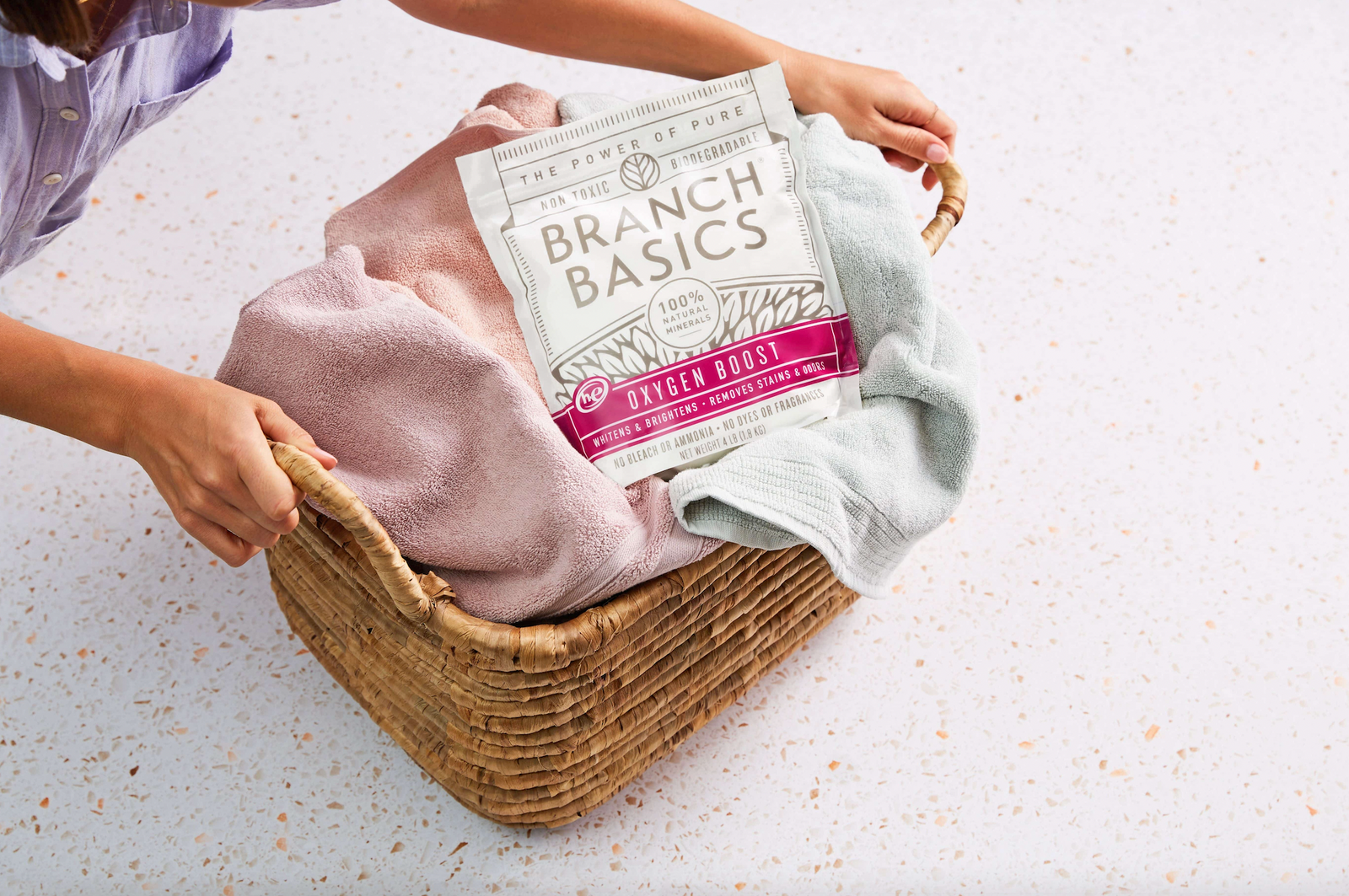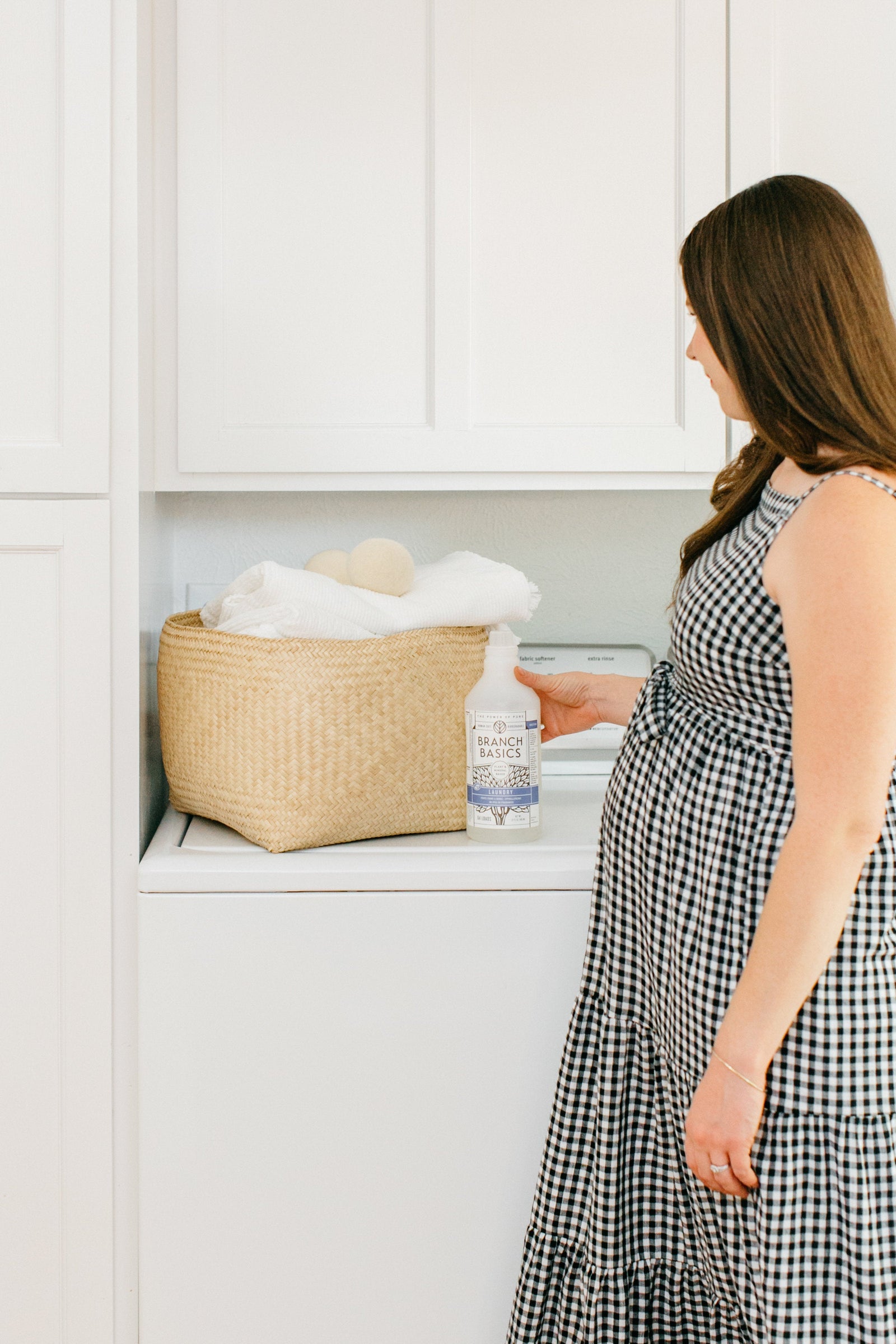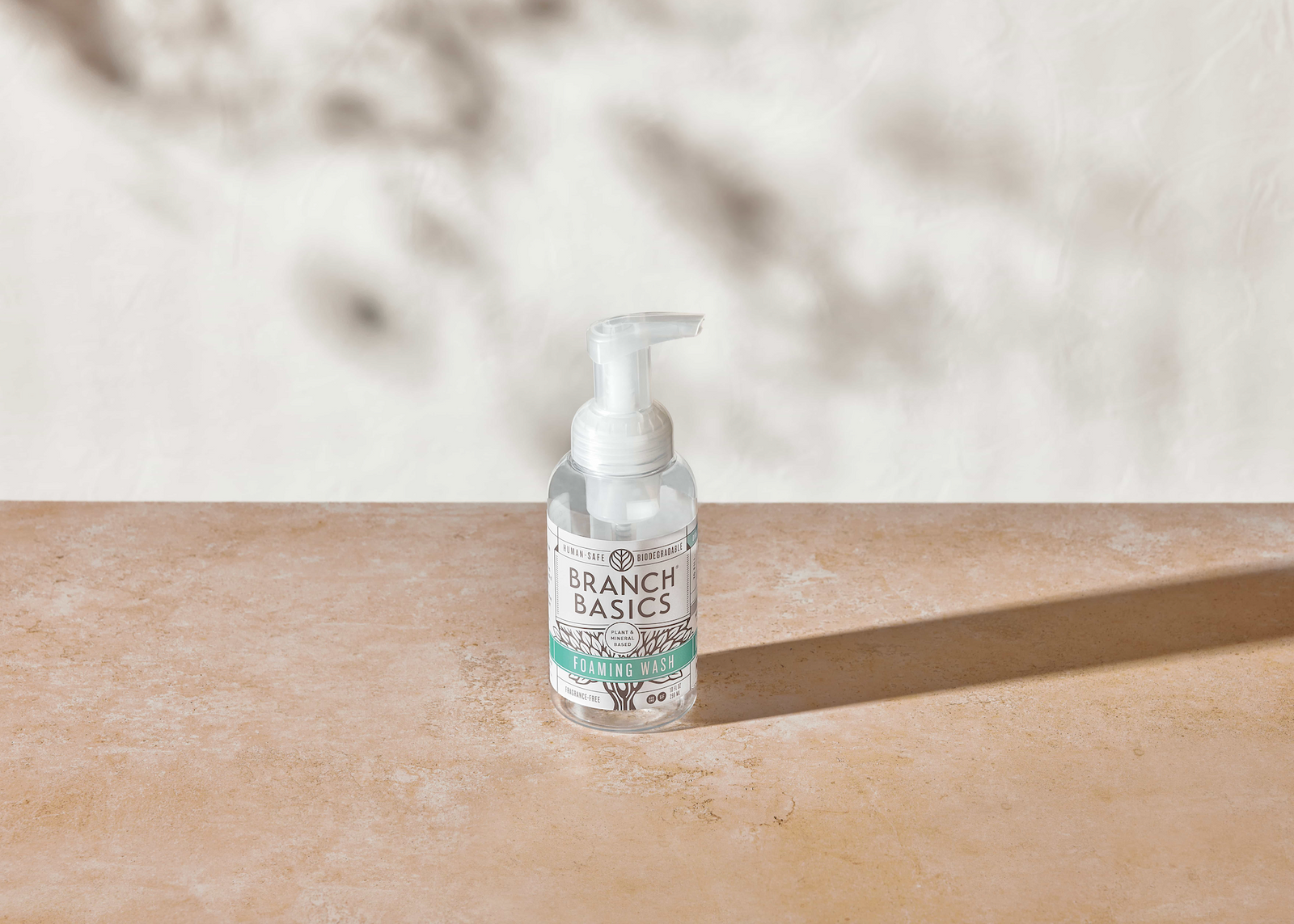7 Toxic Cleaning Products To Avoid & Safe Swaps

If you’ve just started learning about toxic cleaning products and how they impact our health, you’re probably wondering what you’re actually supposed to clean with. After all, most of us grew up believing that harsh chemicals were required for a properly cleaned home.
Unfortunately, those familiar cleaning chemicals we all grew up with are indeed toxic to humans, the environment, and animals (including pets), and should be avoided at all costs.
What exactly do we mean by toxic cleaning products?
There are currently more than 85,000 chemicals in the U.S. that make up the products we use daily... and few have been tested for safety. Toxic products contain one or more ingredients that can cause health and/or environmental harm.
Cleaning products are not regulated, which means there is no requirement for an ingredient list. There is no safety standard but the EPA does require signal words or warnings on labels of poisonous products such as “danger”, “warning” caution”, “corrosive”, and “dispose as hazardous waste." We call these toxic red flags.
Many chemicals in cleaning products are considered toxic because they’ve been shown to cause ill health effects such as cancers, endocrine disruption, obesity, developmental problems, respiratory disease, skin conditions, burns, vomiting, nervous system disorders, and much more. Some can even be fatal if ingested, inhaled or absorbed into the skin.
In this article, you’ll learn the most important toxic cleaning products to avoid and what to replace them with for a healthier body and a much safer home.
#1: Bleach
Bleach is one of the most common household cleaning agents, and its scent is synonymous with sterility. However, although bleach is very effective at killing germs, wiping out surface mold (but only temporarily!), and brightening your whites it’s also highly poisonous if inhaled, swallowed, or if it comes into contact with your skin.
It’s been shown that when we inhale bleach fumes while cleaning or doing laundry, it immediately irritates the mucous membranes of our nose, throat, and mouth. Repeated use over time can cause deterioration of your esophagus, lungs, and respiratory system.
A recent study published in the British Medical Journal showed that even passive exposure to bleach in the home can cause an increased risk of respiratory illness and other illnesses in children.
If all this weren’t enough, bleach can become a deadly gas when mixed with ammonia, vinegar, drain cleaners, alcohol, hydrogen peroxide, dirty water high in organic matter, and other household cleaning products.
Bottom line: bleach is poisonous, extremely dangerous to children, causes a variety of short- and long-term side effects, is awful for the environment, contributes to the proliferation of superbugs, and is completely unnecessary!
Swap With → Branch Basics Oxygen Boost or Peroxide
- For whitening and brightening your laundry, cleaning grout, getting stubborn stains out of clothes, counter tops, surfaces, toilet bowls, sinks, etc. swap bleach for human-safe Branch Basics’ Oxygen Boost.
- For cleaning mold (for which the EPA does NOT recommend bleach because it only kills surface mold).
- For disinfecting, use a combination of hydrogen peroxide and distilled white vinegar stored in separate bottles, and applied separately (eg: spray on white vinegar, wipe off, spray on hydrogen peroxide, wipe off). It’s important not to combine these two (especially in storage) as they can create potentially harmful fumes. So, use and store separately.
- Hydrogen peroxide can also be used on most stubborn surface stains, cutting boards, etc. in place of bleach. It’s also effective at removing blood from clothing, sheets, and reusable menstrual pads, but it can bleach out colors so use with caution.
#2: Fragrance

Pleasant smelling fragrances are generally embraced as a wholesome staple in most American homes.
But like a wolf in sheep’s clothing, they are some of the most toxic chemicals and top allergens on the planet.
The single word “fragrance” listed on the label of laundry detergent, dish soap, or any cleaning product for example, is a synthetic fragrance recipe that may contain hundreds of very toxic proprietary chemicals.
These chemicals are so potent they permeate porous materials like drywall, curtains, and upholstered furniture, which dramatically impacts your home’s air quality over time. Plus, signature fragrances in laundry soap have been designed to impregnate fabrics, making them difficult (but not impossible) to remove.
Bottom line: anything with synthetic “fragrance” (cleaning products, laundry products, candles, air fresheners, personal care products, plug-ins, soaps, etc.) needs to go pronto. Learn more in How To Remove Synthetic Fragrance From Your Home.
Swap For → Fragrance Free Products
- We recommend that only naturally fragrance-free products be used in the home. This is especially beneficial for people with asthma, allergies, mood and attention disorders, hormonal issues, metabolic syndrome, or other chronic health issues as well as for anyone in the family on over the counter or prescription drugs. Results from this study provide strong evidence that fragranced products can trigger adverse health effects in the general population.
- If you choose to use products with fragrance, wildcrafted or organic essential oils processed without solvents are a natural alternative to the very toxic synthetic fragrance recipes. Be aware that inexpensive non-organic essential oils and even some organic oils are processed with solvents and testing has shown that they add an array of toxic chemicals to your home’s air and should be avoided.
#3: Laundry Products

Laundry products such as detergents, stain removers, boosters, bleaches, and dryer sheets contain a cocktail of harmful chemicals for humans, animals, and the environment, in addition to their signature synthetic fragrances.
Per the Environmental Working Group, chemicals found in dryer sheets and fabric softeners are considered to be among the most toxic in the laundry category.
Some of the most common and harmful ingredients include: benzyl acetate, limonene, chloroform, dichlorobenzene, benzyl alcohol, camphor, biodegradable cationic softeners, alpha terpineol, pentane and linalool.
Each ingredient causes unique problems, but they all can irritate eyes and skin, cause respiratory issues, endocrine/reproductive issues, and damage the nervous system.
Unfortunately, many of these chemicals are present in chemically-based and “natural” or “green” laundry products. So it pays to read labels and pay attention to detail.
Swap With → Branch Basics Laundry, Oxygen Boost, All-Purpose, Wool Dryer Balls, Distilled White Vinegar & Baking Soda
- Branch Basics Laundry can replace any laundry detergent and is safe to use for delicates and hand-washing.
- All-Purpose works great as a spot and stain remover.
- Oxygen Boost can be used in place of boosters or bleach to brighten clothes, remove odors (works great for cloth diapers), as a soaking agent (works great on baby stains) and in combination with All-Purpose to remove stubborn stains.
- Wool Dryer Balls replace fabric softener and dryer sheets and can be re-used for years and years.
- Other natural products like distilled white vinegar and baking soda may also be helpful when dealing with hard water and cleaning/detoxifying your washer and dryer.
Get the full details on how to detoxify your laundry room here.
#4: Ammonia
Straight ammonia isn’t as common as it used to be in household cleaning. However, it is still common in manufactured cleaning products like window cleaners, floor cleaners, etc.
Ammonia hydroxide, found in window cleaners for example, is considered a “high hazard” by OSHA and can cause severe skin burns and eye damage, irritation to mucous membranes, respiratory problems, and life-threatening pulmonary edema. It’s also extremely toxic to aquatic life.
Swap With → Branch Basics Streak-Free Or Distilled White Vinegar
- Branch Basics Streak-Free or distilled white vinegar can be used to achieve a streak-free shine on windows, mirrors, door knobs, etc. Keep in mind that although vinegar is a natural product, it contains acetic acid which is a respiratory irritant when made airborne by spraying.
- So if you’re sensitive, have a respiratory condition, babies or young children in the house, etc. opt for Streak-Free.
#5: Antibacterial Cleaners

Antibacterial cleaners used to be the “gold standard” in effective cleaning and disinfecting. However, new evidence shows that these harsh cleaners, including bleach, alcohol, and other antibacterial chemicals, are hazardous to the environment, contribute to the superbug issue, and damage our immune system making us more vulnerable to contagious disease.
Plus, they impact our microbiomes which directly affect our immunity, digestive health, respiratory system, hormones…and pretty much everything in our bodies.
Swap With → Branch Basics All-Purpose followed by Distilled White Vinegar And/Or Peroxide
- We’re not fans of over-sanitizing, but sanitization/disinfection is sometimes necessary in order to prevent the spread of harmful bacteria, illness, and other pathogens. The CDC actually discourages the use of antibacterial cleaners and instead suggests that all surfaces in a home be cleaned with plain soap and water (such as Branch Basics All-Purpose) to remove all germs followed by the use of a disinfectant ONLY on frequently touched surfaces.
- When heavy duty cleaning is warranted (such as cleaning a cutting board after cutting raw meat, disinfecting toys, pacifiers, after illness, etc.), we recommend cleaning first with hot water and soap (Branch Basics All-Purpose), rinse and then spray the surface with hydrogen peroxide and/or distilled white vinegar used separately and stored in separate bottles. We affix a spray nozzle directly to the manufacturer's bottles for convenience.
#6: Drain Cleaner
Drain cleaners are some of the most toxic and poisonous cleaning solutions in the American household.
The main ingredient, sodium hydroxide, is so caustic that ingestion can cause burning of the mouth, esophagus, and stomach, other internal tissue damage, extreme abdominal pain, difficulty breathing due to throat swelling, a rapid drop in blood pressure, collapse, and even death .
The fumes can cause respiratory damage and extreme illness, skin exposure can cause severe burns, eye exposure can cause vision loss, and it’s also extremely toxic to the environment and aquatic life… not to mention completely unnecessary.
Swap With → A Plunger, A Snake, Baking Soda And White Vinegar
- Most clogs can be dislodged with a plunger (they even make these handy sink plungers), a drain-snake, or even an old coat hanger.
- You can also dissolve clogs by adding non-toxic baking soda and distilled white vinegar to your drain. Let sit a few minutes, then rinse with very hot water. Repeat until the clog is dissolved.
- Some people swear by using soda/cola to dissolve clogs. Although we can’t attest to this, we do believe it’s the only appropriate use of sodas (and a great way to get it out of your fridge and pantry).
#7: Dish Soaps And Detergents
Most dish soaps contain foaming chemicals known as SLS or SLES which can cause a variety of skin irritations, surfactants which have been banned in other countries due to disrupted physical function and fetal development, and toxicity to aquatic life
However, the chemicals in dish detergents (the type that go into your dishwasher), are much more poisonous. In fact, dish detergents are the leading cause of childhood poisoning in the United States.
What makes them so dangerous is the alkaline chemicals, which are corrosive in nature. This makes them caustic to skin, tissue, and internal organs. Liquid detergents are the worst, and can have an alkalinity as high as 13, making them extremely dangerous…especially for children.
Swap With → Branch Basics All Purpose or Bathroom and Dishwasher Tablets
- To replace dish soap (for handwashing dishes) you can spray Branch All Purpose or Bathroom Cleaner directly onto your dishes, or into your sink, and wash like normal.
- Replace dish detergent with Branch Basics Dishwasher Tablets. Note: All Dishwashing Tablets should be kept out of the reach of children. They look like a piece of candy and something good to eat!
We discuss this topic at length in: Why Safe Dishwashing Is So Important.
Toss the Toxins with Branch Basics
This list is a great place to start in detoxifying your home of the most harmful and dangerous household cleaners and chemicals. Check out this article for more tools to help you become your own product advocate!
If you’re interested in learning more and taking it a step further, be sure to check out our Toss The Toxins online course. In the course, our co-founders take you through the home detox process step-by-step, category by category—from cleaning products to foods, personal care products, and more, including tips on the best safe replacements, safe and responsible disposal, and much more.

Marilee Nelson
Marilee Nelson is an Environmental Toxins expert who has spent nearly 30 years advocating for the chemically-sensitive and chronically-ill. She is a Board Certified Nutritionist, Certified Bau-Biologist and Bau-Biology Inspector and specializes in Food As Medicine. She has helped thousands of families and individuals identify, heal and recover from toxic exposures and is on a mission to revolutionize the way American families view their health.








